ESCAPE
The Williston Way – memories of a great cultural festival
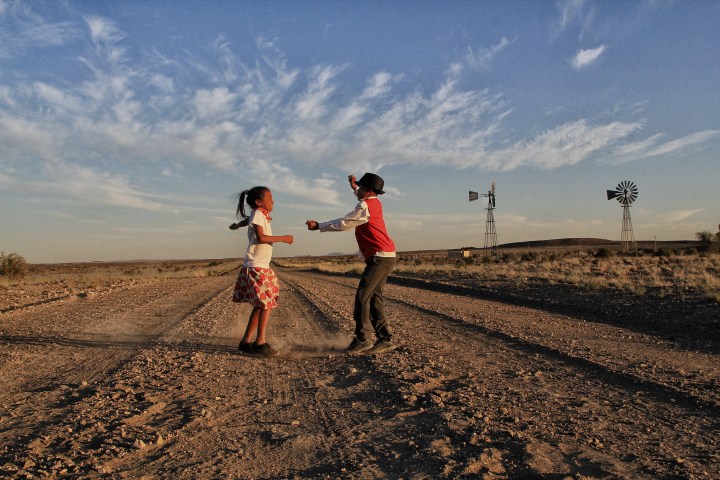
Chris Marais reminisces about times spent at the Williston Winter Festival, a cultural festival like no other, deep in the Northern Cape Karoo.
We’re sitting on a small koppie overlooking the Northern Cape village of Williston and there seems to be a lot to think about this morning.
The full moon is just setting, the sun is about to rise and the sky is a layer cake of lavender and salmon. It’s always fun watching a Karoo settlement wake up. A young boy emerges from his family house to sweep the stoep. A rooster crows, and all his mates on the block follow suit. Two all-night revellers dance slowly down the street, clink each other’s wine bottles and collapse in the dust, laughing hoarsely.
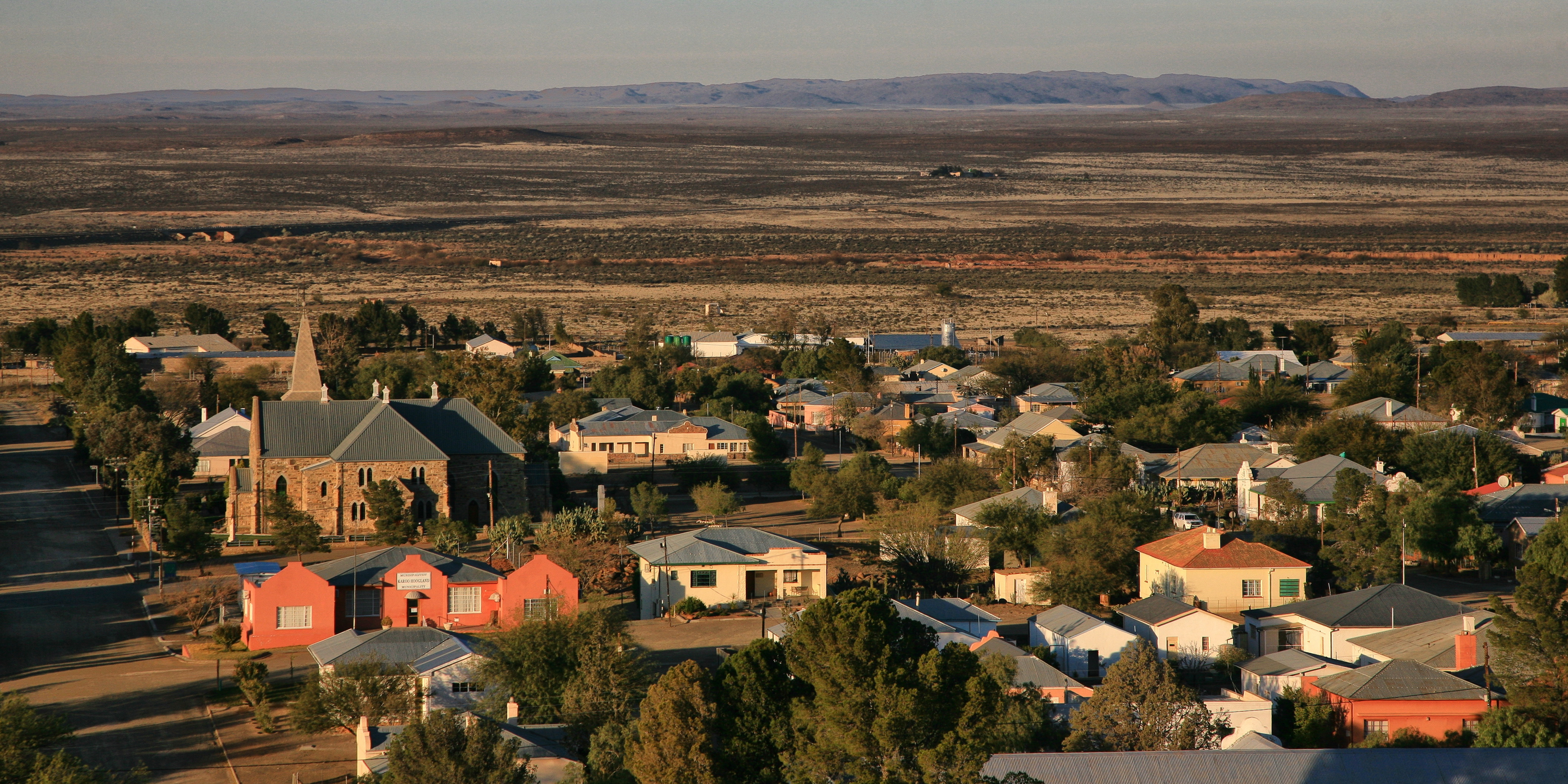
The Upper Karoo town of Williston waking up to a new day. Image: Chris Marais
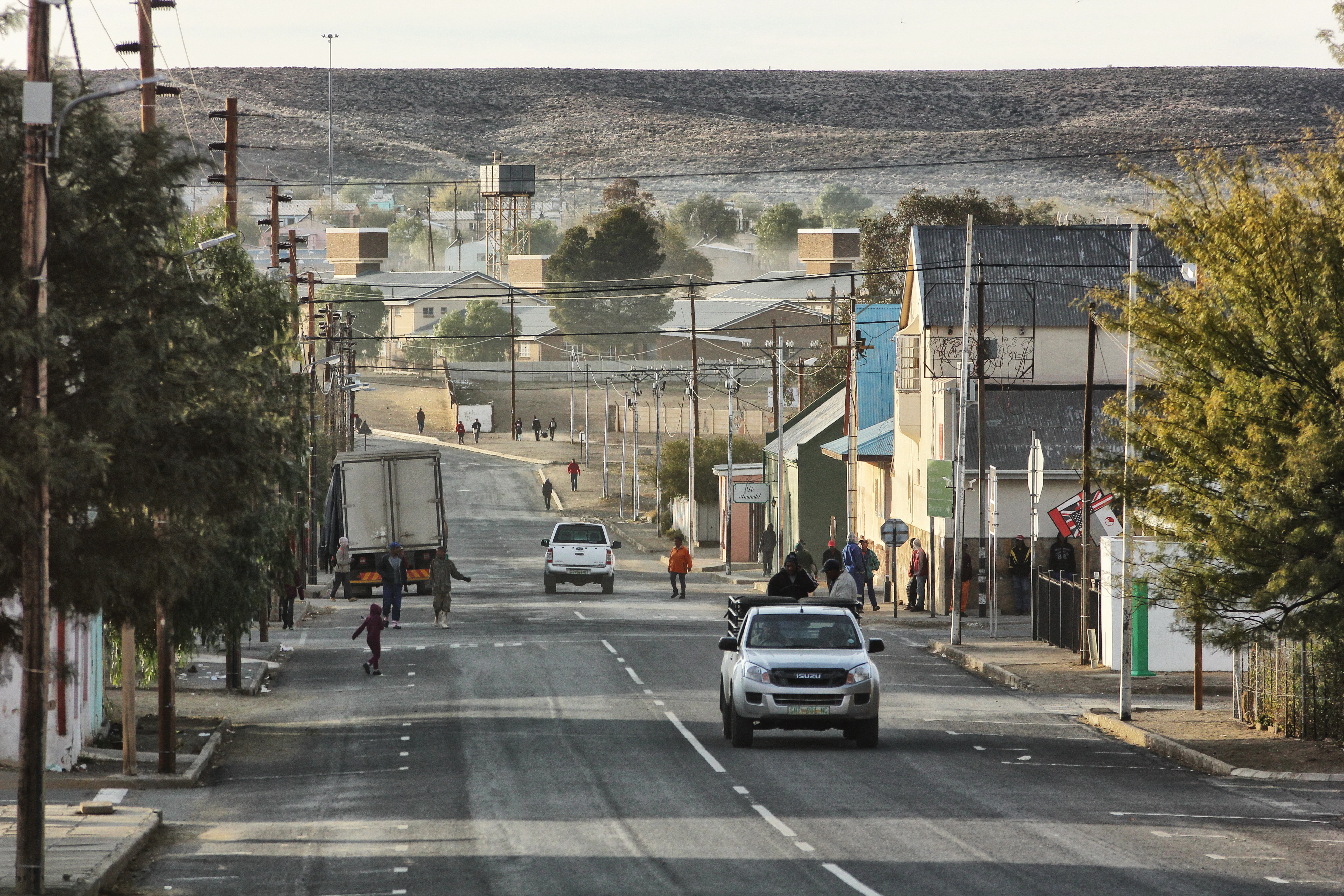
Early-morning street scene in Williston, a typical small Karoo farming town. Image: Chris Marais
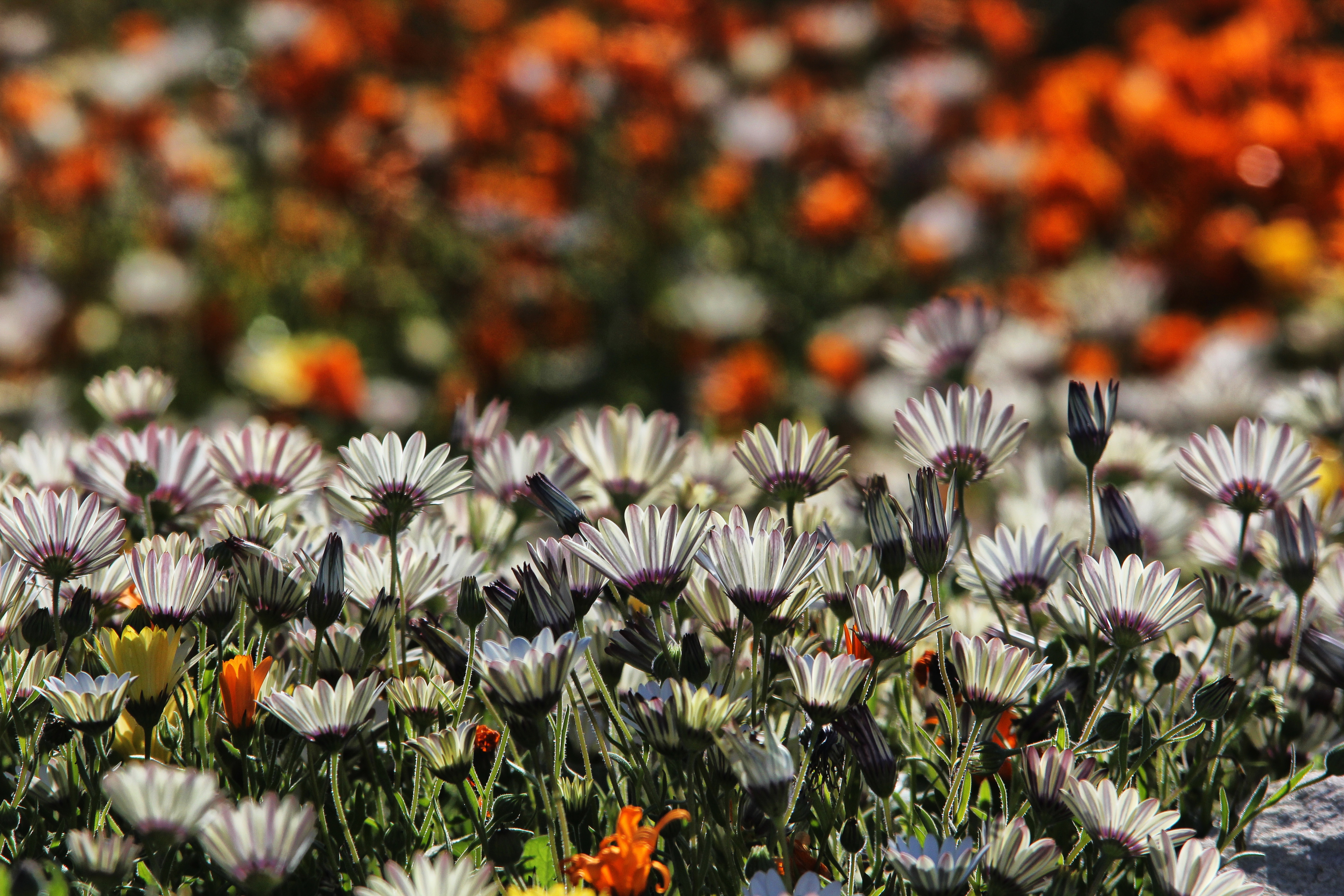
Springtime flower beds are to be found all the way from Williston to the West Coast. Image: Chris Marais
This particular morning, we descend the koppie and head back to Die Ark at the Williston Mall, where we are lodged in a room with the evocative name of Slopie se Kooi. There’s a rugby game on between the Boks and the Wallabies, and we join our hosts, artists Pieter and Elmarie Naude, and a bunch of locals for two hours.
“Elmarie can’t watch,” says Pieter. “She’s just bad luck.”
So the feisty Elmarie Naude takes up her post at the window outside, giving us the benefit of her vast rugby knowledge. She adds new meaning to the term ‘running commentary’. The Boks lose anyway.
Follow the Full Moon
That night, we’re at a braai with Jan and Elna Marais down the road and a typical Karoo feast is laid before us: skilpadjies (liver wrapped in fat), lamb chops, plaaswors, and pudding consisting of quinces and stewed peaches.
Jan hears about our dawn patrol and tells us a story: “There was this guy here in Williston who drank at the hotel every night. And when he wobbled home, he would use the lit-up sign from the Shell filling station as his guiding light.
“One night, when it was full moon, someone had forgotten to switch the neon light on. So the drunken man followed the full moon instead, all the way to one of the wildskampe outside town. And that’s where they found him the next morning.”
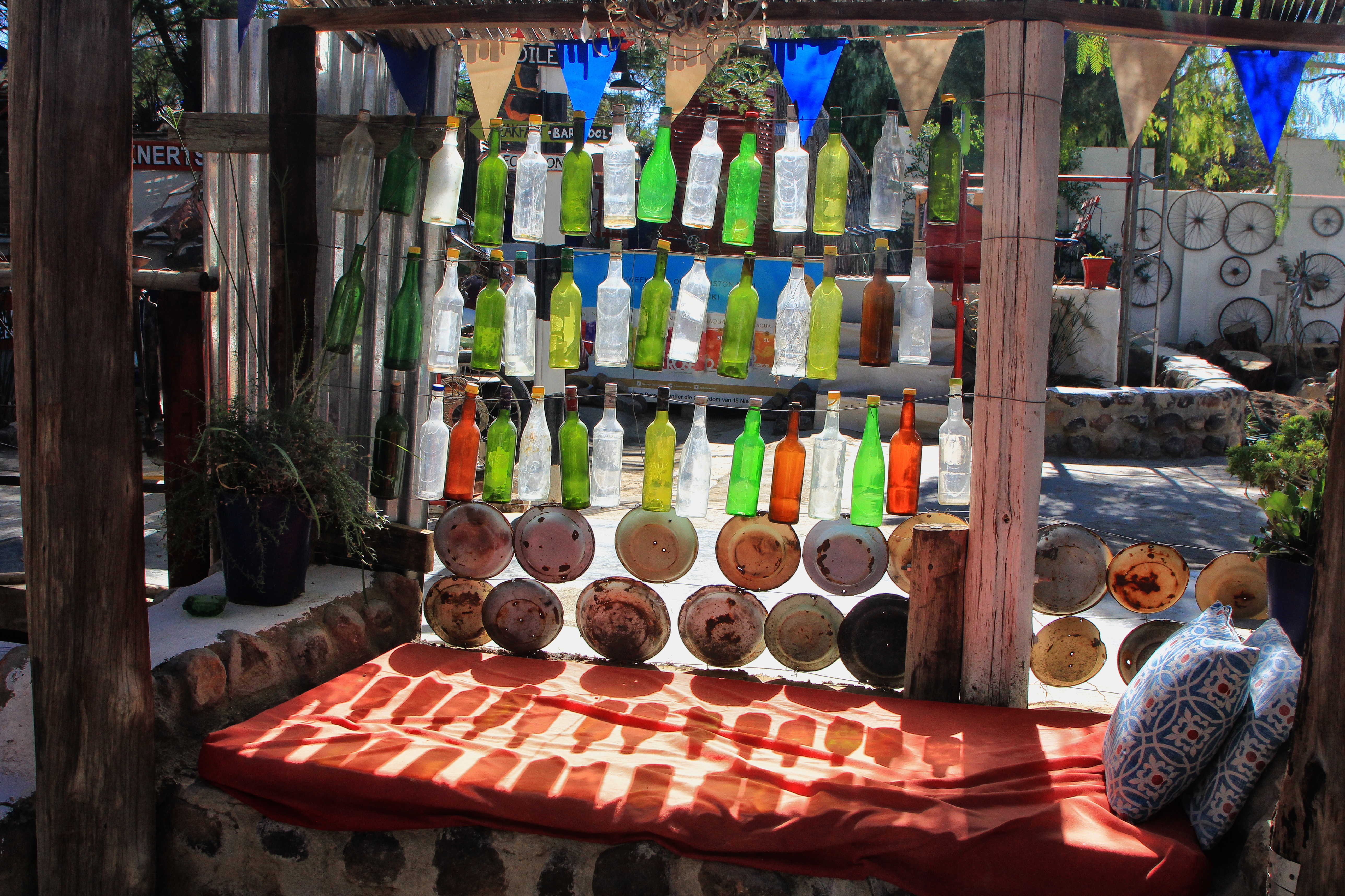
One of the Williston Mall nooks provides shade from a punishing Northern Cape summer. Image: Chris Marais
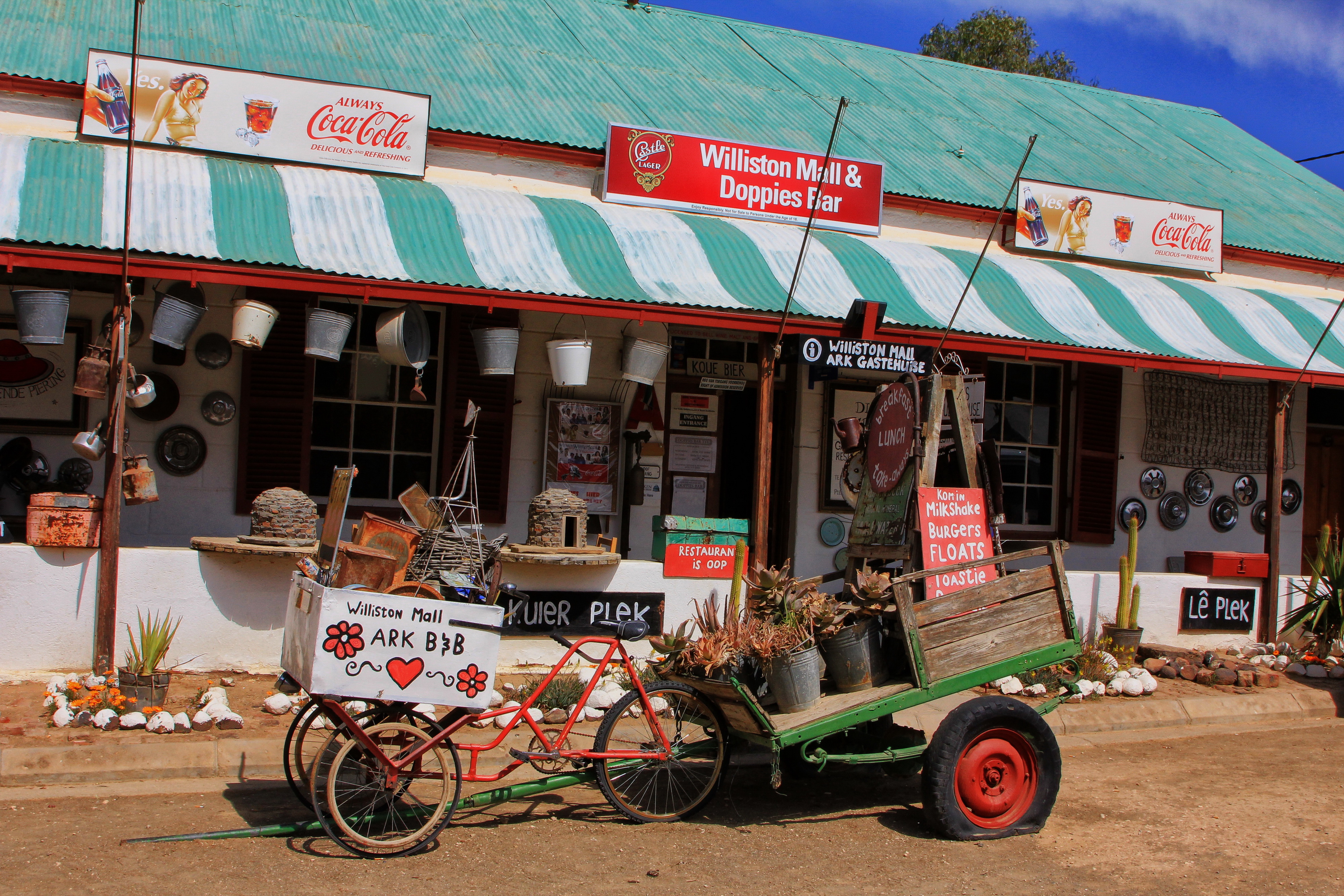
The Williston Mall – a firm fixture on Karoo road trippers’ itineraries. Image: Chris Marais
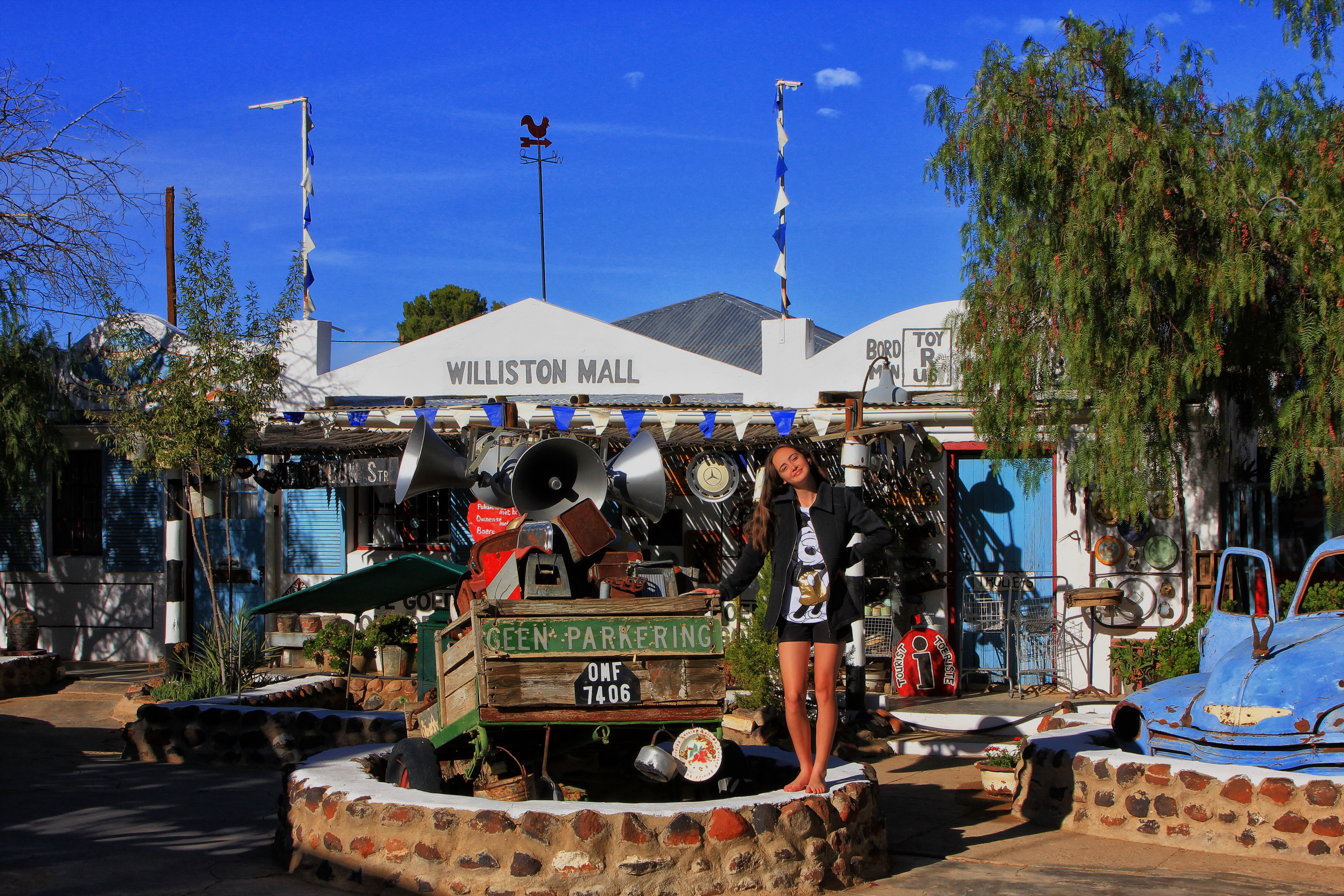
Bianca Naude grew up in the Williston Mall. Image: Chris Marais
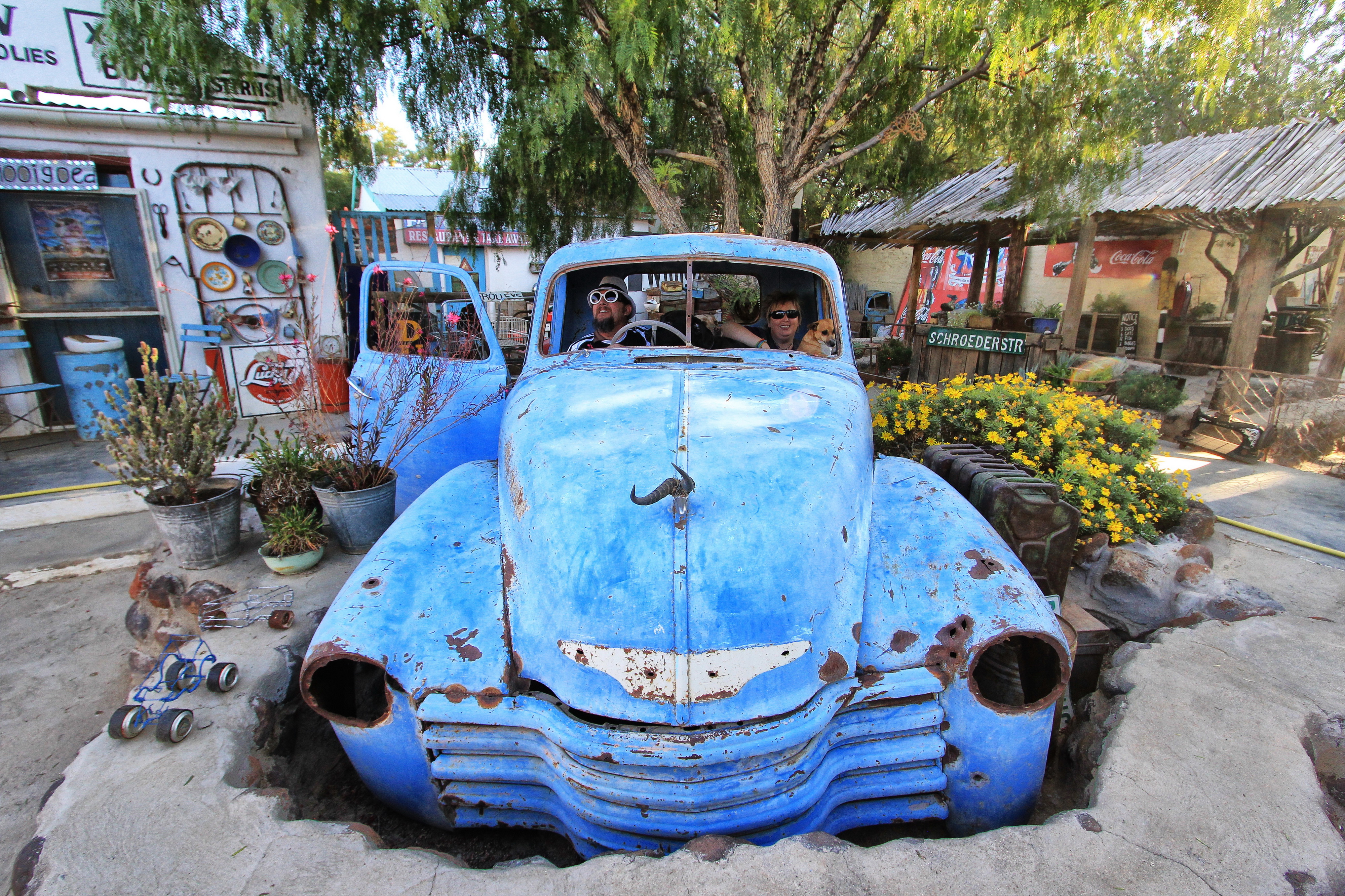
Pieter and Elmarie Naude with their dog Koeks in the courtyard of the Williston Mall. Image: Chris Marais
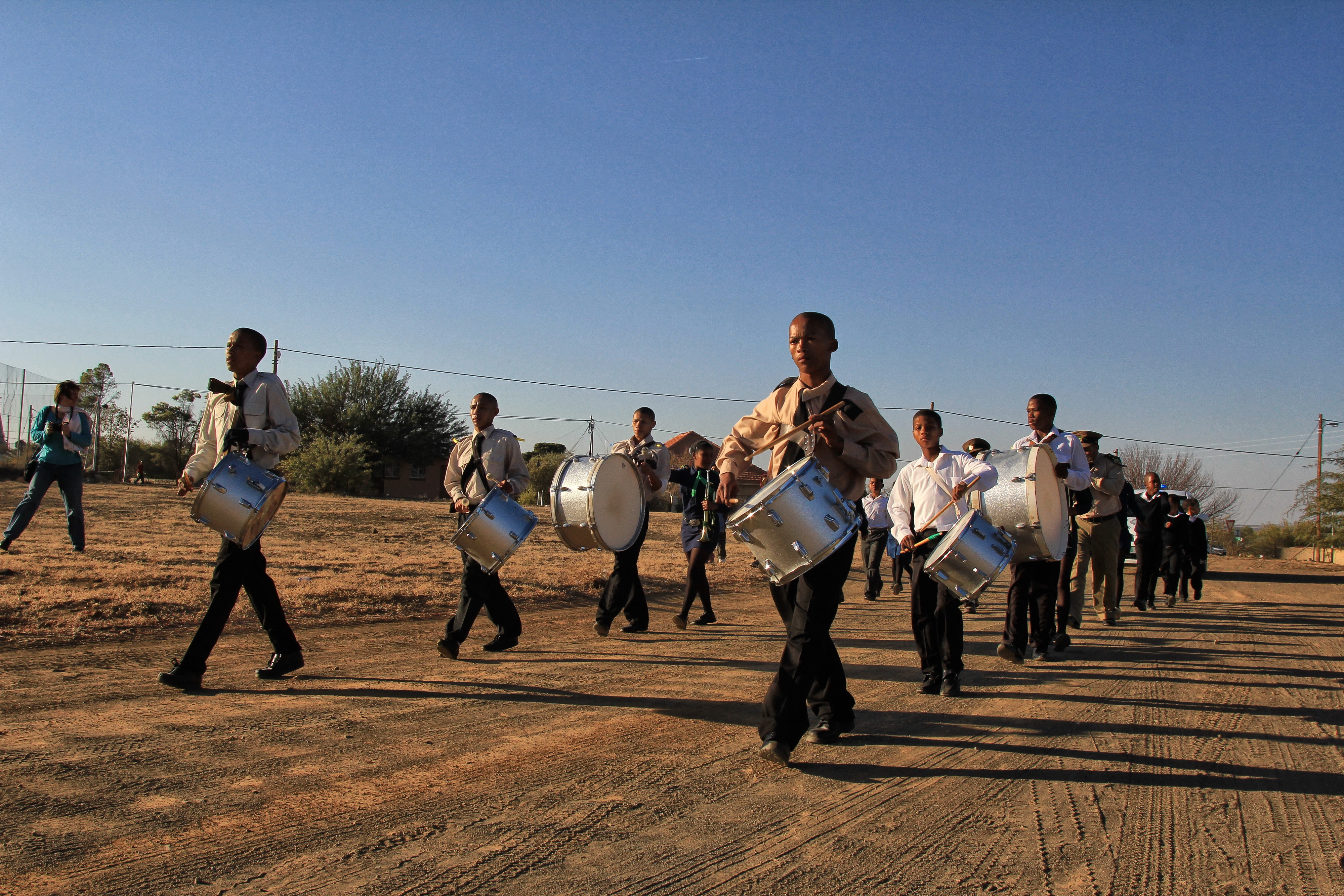
The marching band that used to break neighbourhood hangovers on a Sunday morning. Image: Chris Marais
Karoo Oasis
We fall in love with this dry little settlement in the middle of a Northern Cape nowhere right back in 2007, when we drive in dusty, dirty and thirsty after a magazine assignment somewhere between Kenhardt and the blue horizon.
We find the Williston Mall, a converted backyard that has ducks in a pond, old enamel signs and a hessian-covered lapa that comes with Wi-Fi and the best damn milkshakes in the whole history of milkshakes. And there’s Elmarie, all smiles and stories and near to bursting with Bianca, her baby girl a month away from this world. She shows us the ultrasound image of a tiny floating figure with her arm thrown dramatically over her head.
“And here’s our wedding photo, the day Pieter and I were married barefoot.”
Elmarie forgets to mention the fact that, in the photograph, she is clutching a tame baby porcupine for a posy.
“Oh yes, my porcu-pet,” she laughs.
Williston Winter Festival
In the ensuing years, we establish a modest Karoo Space Trade Route in the tradition of the Lithuanian wagoneers (die smouse) of old. We drop our wares (in this case, Karoo books) off at a series of little shops all along Route 63: McNaughton’s in Graaff-Reinet, Kweperlaan in Murraysburg, Karoo Deli in Victoria West, Rooi Granaat in Loxton, the Hantam Huis in Calvinia and then, swinging back, the Williston Mall. And we always time it for the day before the Williston Winter Festival, Elmarie and Pieter Naude’s brainchild event that lights up the whole district, from the kolke of Brandvlei to the vlaktes of Middelpos and every farmstead in between.
Read in Daily Maverick: Williston, a Karoo Hoogland farming town – almonds, hard rocks and the Nama Riel
Our first festival is a huge affair in 2010, complete with boere pop singers, arm-wrestling identical twins (“Triplets, actually. We have a sister back in Calvinia.”), a drama squad from our hometown of Cradock, Saturday afternoon Karoo club rugby at its bashing best, a marching band that specialises in waking the hungover locals on Sunday mornings, and dear Uiltjie, aka Magrieta Botha, the lady with the donkeys.
Botha wore a sensible trekboer sun bonnet and, when we first meet, drove a brace of donkeys called Pootjie and Saartjie, from her nearby farm to Williston to trade and pick up supplies. Every year, like a fond pilgrimage, we would hunt her down and ask after her donkeys. One time, she tells us in grave tones:
“Pootjie has gone to another home. Now I have Kleinveld spanned in with Saartjie.” Good to know. She adds:
“And while I’m training them, I play country music. It gives them rhythm. Now Saartjie, she has learnt to wait at a farm gate while I get down and open it – but only for so long. She’ll look back twice, and that’s it. If you’re not up by the second look, sorry for you. Off she goes.”
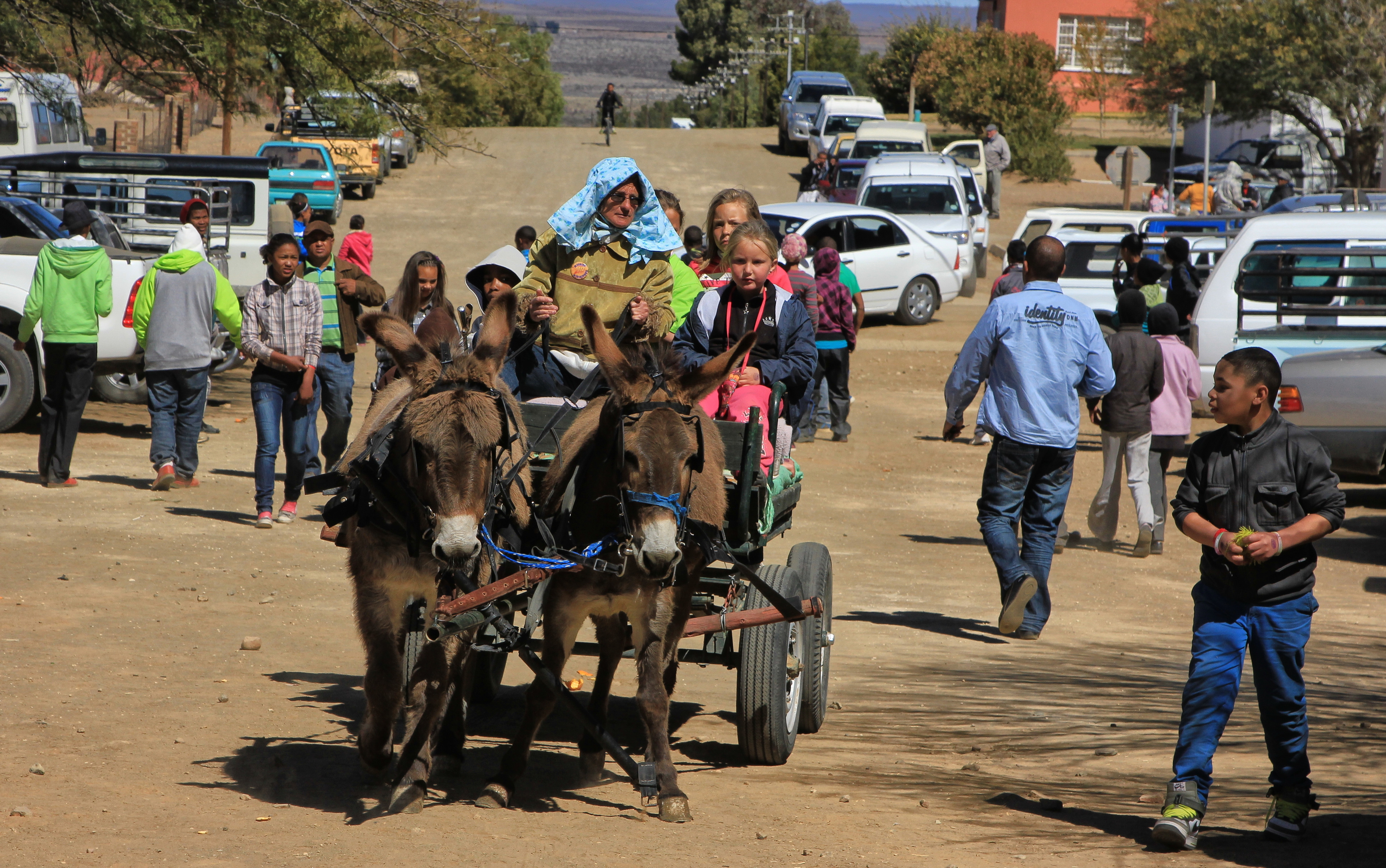
Magrieta Botha and her donkeys were always a feature of the festival. Image: Chris Marais
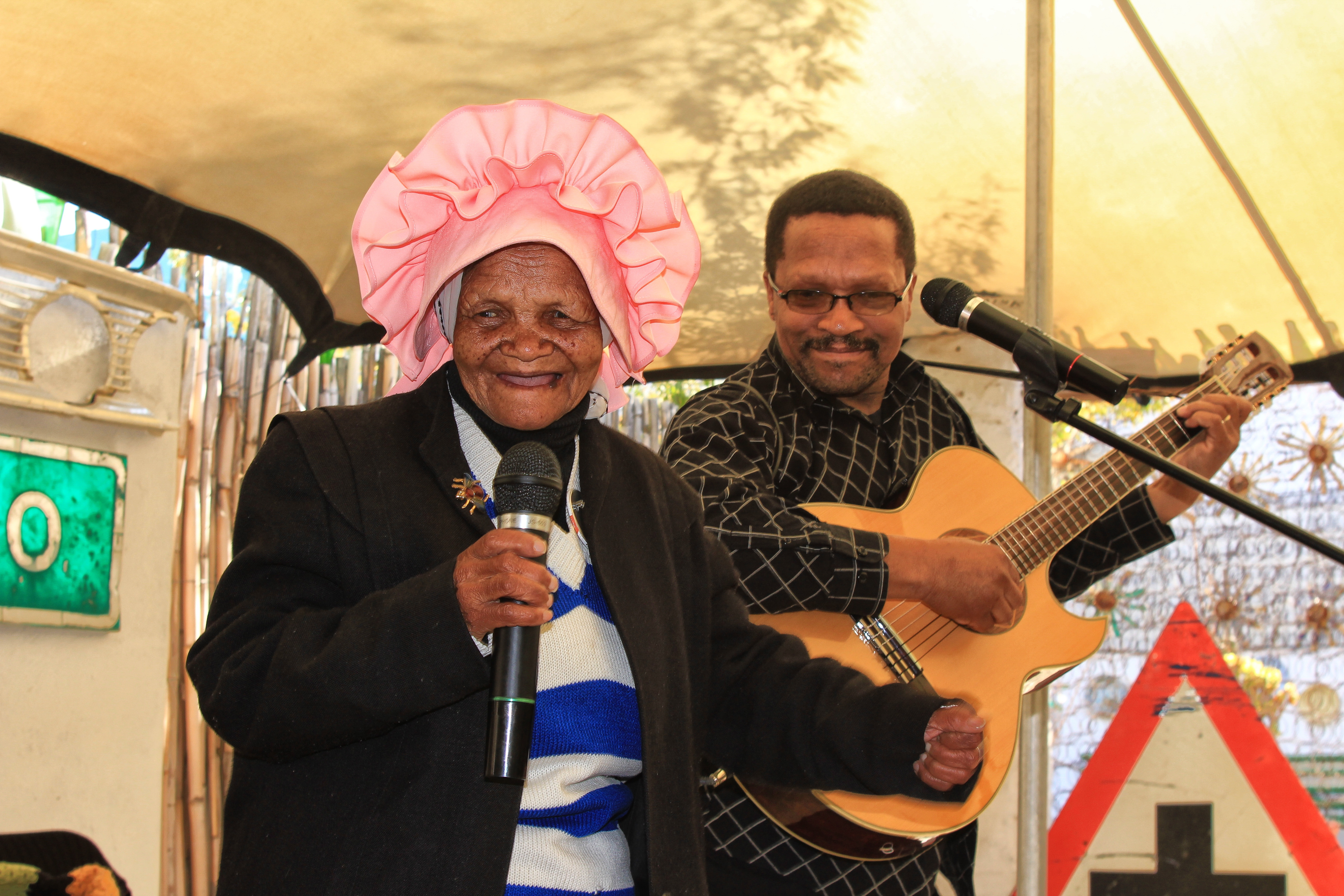
The late Tannie Grietjie Adams of Garies was a favourite at the 2010 festival. Image: Chris Marais
Tannie Grietjie from Garies
The headline act that year is Grandma Adams of Garies, Tannie Grietjie to the world at large. The 83-year-old Namaqualand rap singer of Lekker Ou Jan fame. We drive out to the old age home at Amandelboom where, it is rumoured, Tannie Grietjie was about to make a personal appearance.
The story goes that Tannie Grietjie has a special relationship with the number 13. They say she wears number 13 shoes (kiddie size surely), she’s one of 13 siblings and has borne 13 children herself. This was also her 13th year of performing with the ebullient Pieter van der Westhuizen, who makes that Spanish guitar of his tjank like nobody’s business. And there they were, making merry in the midst of old Zimmer frames, coffee and beskuit, peeling chairs and deep, wrinkled grins. Tannie Grietjie, pink kappie on her head, with Pieter on rhythm guitar, is singing a peculiarly high-pitched country rap number – and boogieing with the old folks.
Kalahari Orkes on the Septic Tank
One year later, we are westward-bound once more, our trusty old Isuzu bakkie laden with books for delivery en route to Williston, where festival fever is rising. Kind shop ladies take sealed printers’ boxes from us and hand over little bank bags of cash in lieu of last year’s sales. They press coffee, roosterkoek and home-made jam on us and we gratefully accept. Route 63 has many blessings.
The September winds are howling through the village as we go in search of Elmarie Naude and our lodgings. She’s in a right state.
“The Kalahari Orkes have parked on the underground septic tank! I can’t find them and the honey-sucker truck is waiting to do its business.” She rushes off to find the guy with the keys.
Over at the Williston Winter Festival site, which was the local municipal campground only last week, the wind is shaking the hell out of various marquees, canopies and stall tents. Once again, the Naudes’ nerves are shot.
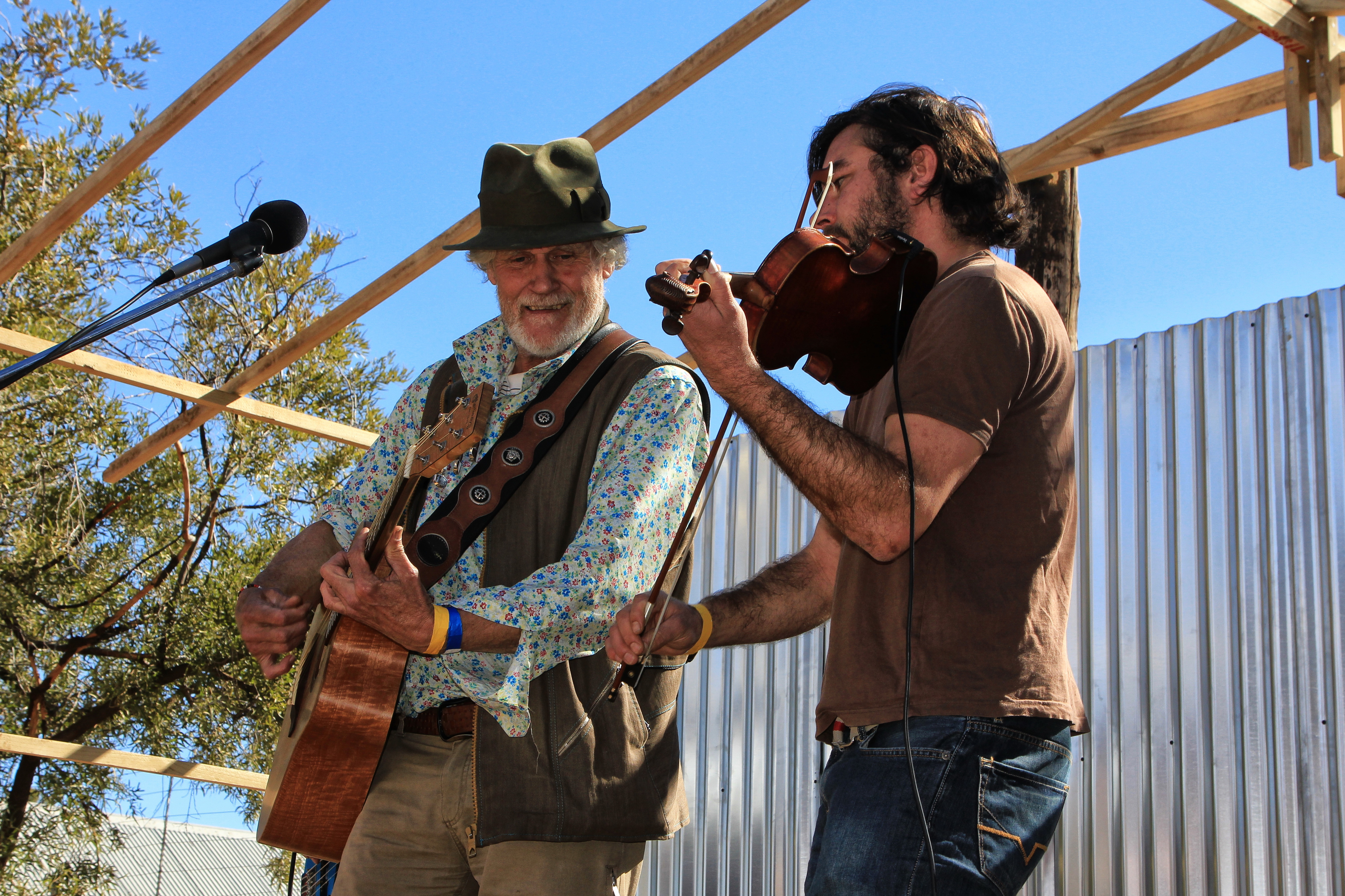
Part of the Kalahari Orkes on one of the outdoor stages. Image: Chris Marais
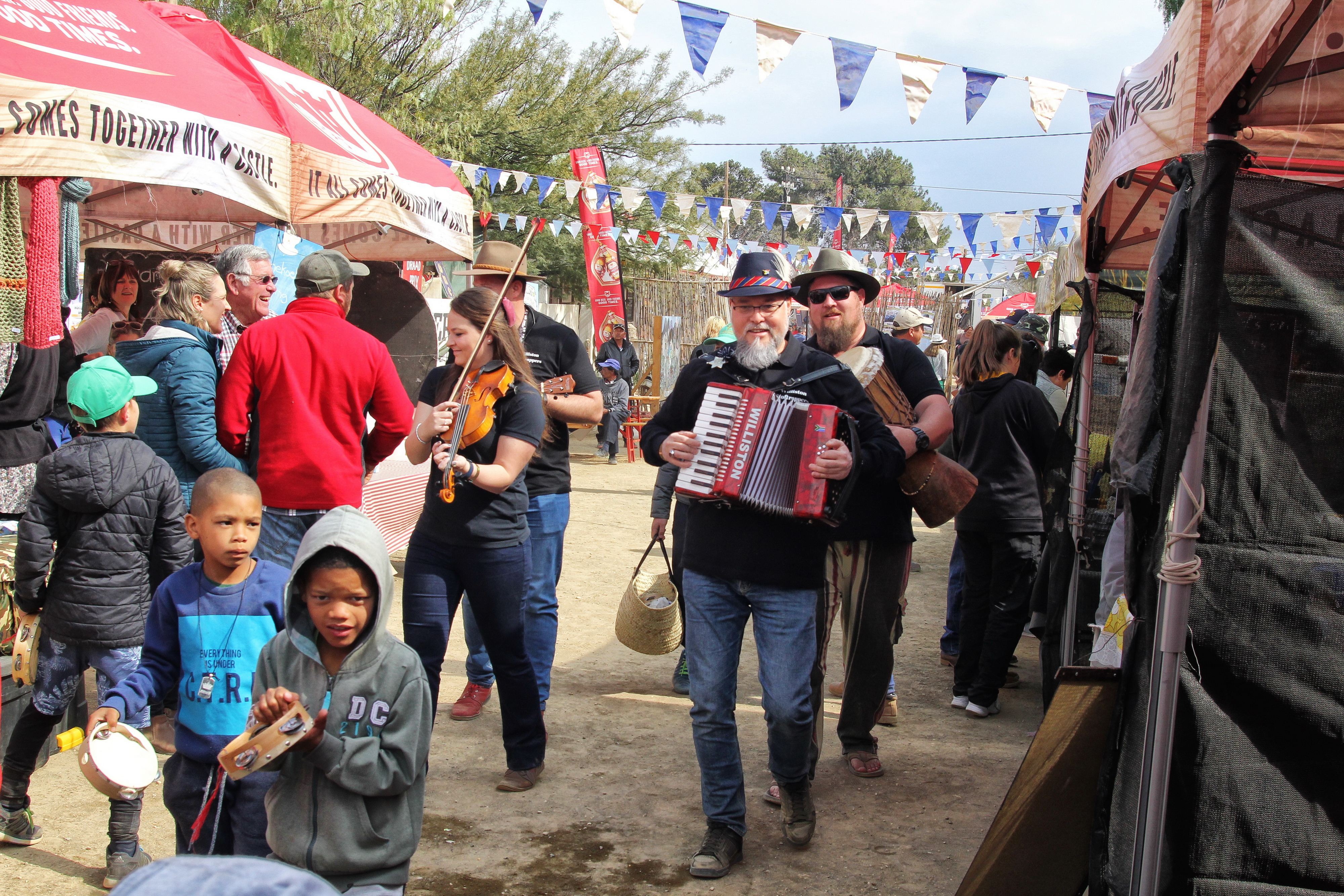
Johann de Jager leading his Williston Stoftrappers at the 2018 festival. Image: Chris Marais
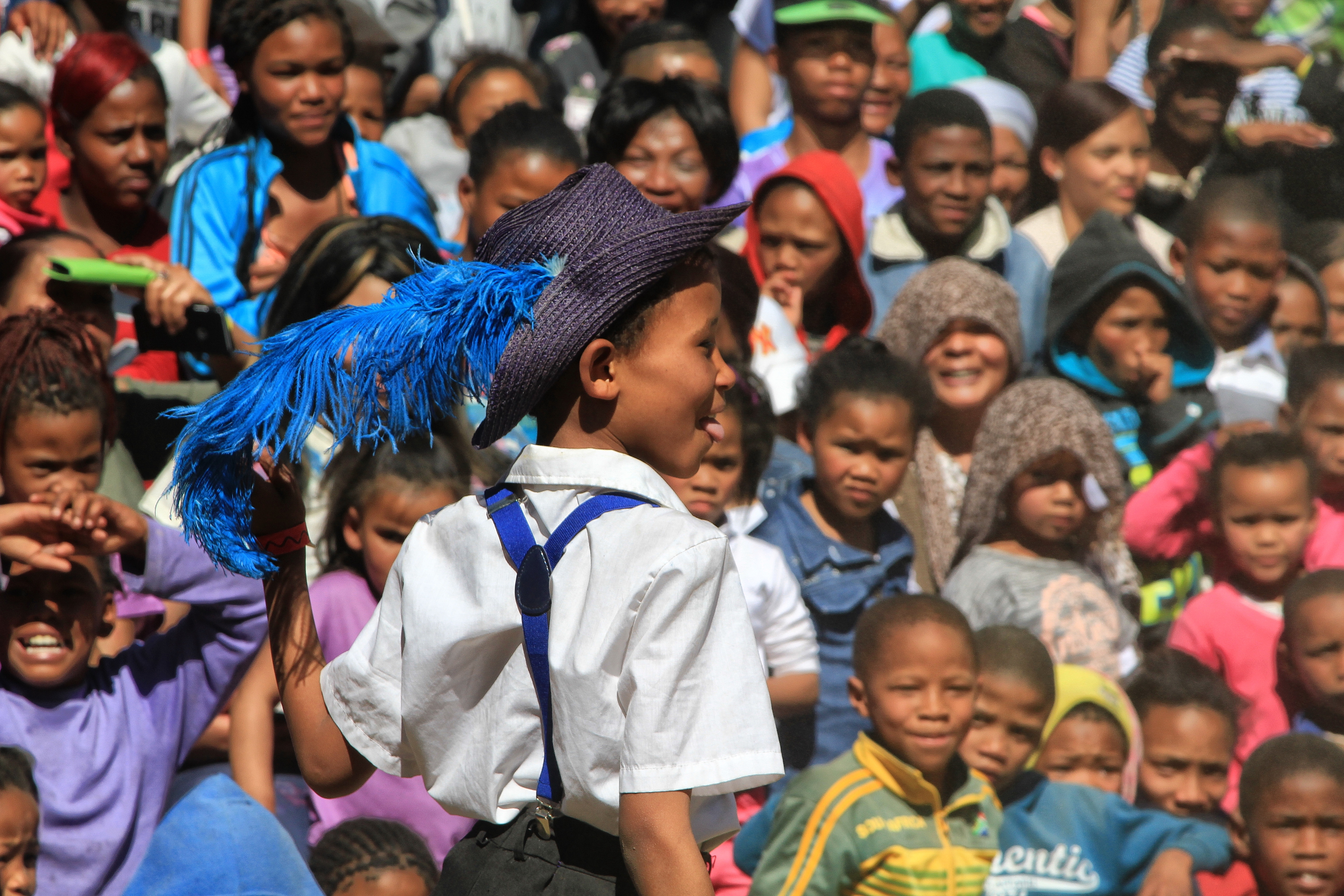
The Williston Winter Festival was a great joy for both the dancers and the crowd. Image: Chris Marais
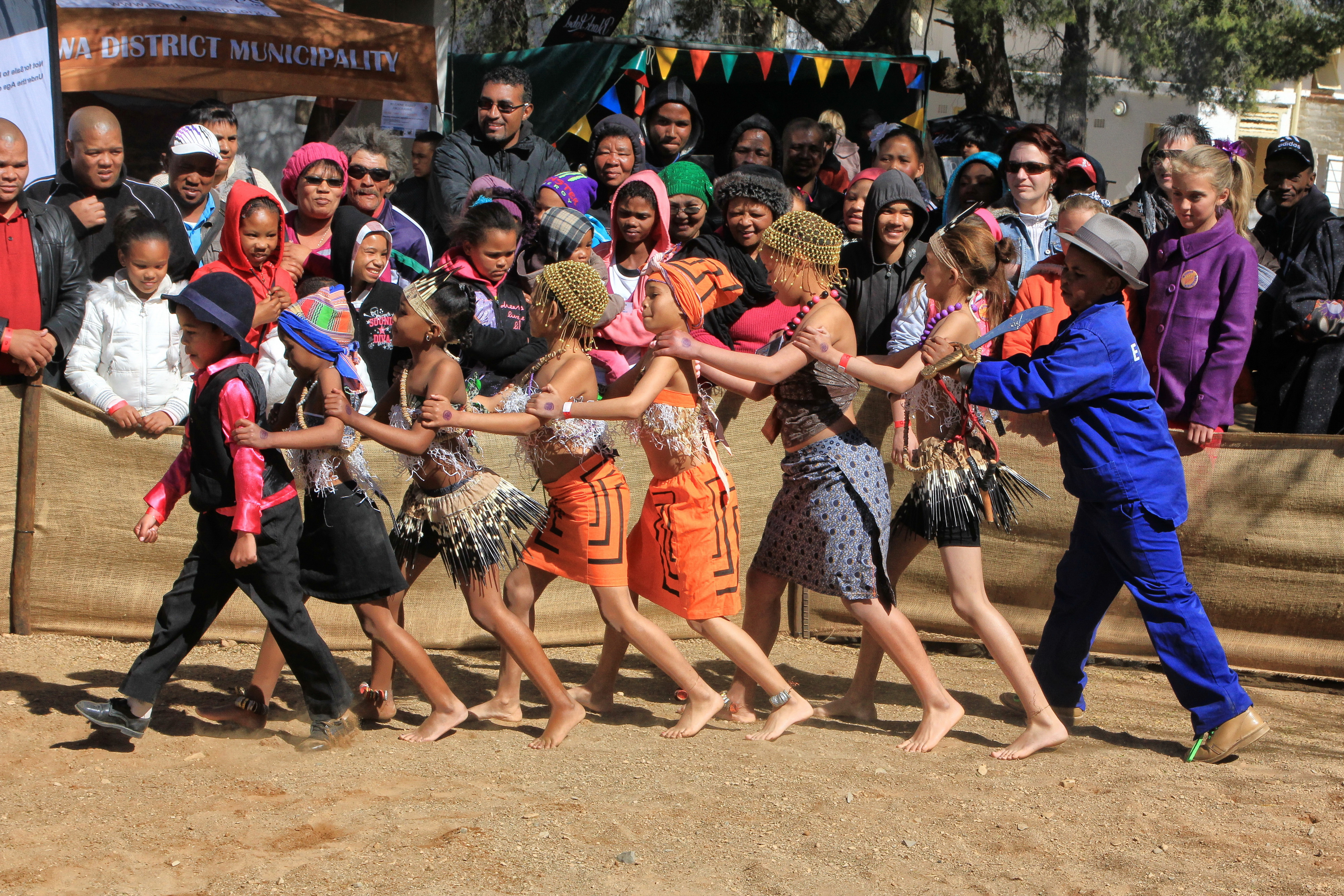
Dressed in smart formal, Khoisan tribal and universal Karoo blue farm gear, the young dancers form a conga line. Image: Chris Marais
The Leyland Sheep Truck Gig
What a festival! There’s a huge lineup of musicians once more, but this time we have Boeta Gammie, the Kalahari Orkes and the Silver Creek Mountain Band as the big stars of the show. The Creek are directed to their performance stage, which was the back of a well-worn Leyland sheep truck only this morning, and they roll with the vibe of it all. By now the charismatic owner of the Faerie Glen Game Reserve outside Cape Town, Johann de Jager, has also become a regular festival fixture. He plays the piano and the Krismiswurm (accordion) and handles the crowds like a maestro – with both glamour and kindness.
The wind dies down, Pieter Naude’s blood pressure normalises, the Silver Creek Mountain Band launch into a country waltz and the crowd are doing a lang-arm dance, weaving around the lit konkas (braziers) of the Williston Mall. We fret about double-bass player Rod Dry’s legendary bare feet on the cold metal floor of the truck, until we see he’s been sorted by way of a rubber mat. A faint whiff of sheep dung still hangs in the air around the truck.
Donkey hijack
The next morning, we report to the showgrounds for our annual Uiltjie Update. Fresh news is that her two beasts were donkey-jacked yesterday. They simply disappeared from the post where she tethered them, and a bunch of children were disappointed to hear there would be no donkey rides. But you don’t really want to mess with Magrieta Botha or her donkeys. She storms down to the local police station to report the theft, and the cops give her the cold shoulder until she throws her toys out of the cot. To placate the irate Uiltjie, they venture out and track the donkeys to behind one of the railway houses on the edge of town. A couple of kids have nicked them for a free joy ride. No criminal charges were laid.
On Saturday morning we come across an exhausted Pieter Naude at the showgrounds near the Lavazza coffee truck, clutching a big mug of the stuff.
“Can you believe it?” he exclaims. “The stall holders have started beating each other up over their positions.”
I am The Rooster!
Die Hoenderman (The Chicken Man) is bedecked with mask, yellow goggles, overalls with chicken clawprints, a cape made from a red fitted sheet, boots and welding gloves.
If anyone asks him what his name is, he replies:
“Ek is die Haan! (I am the Rooster).”
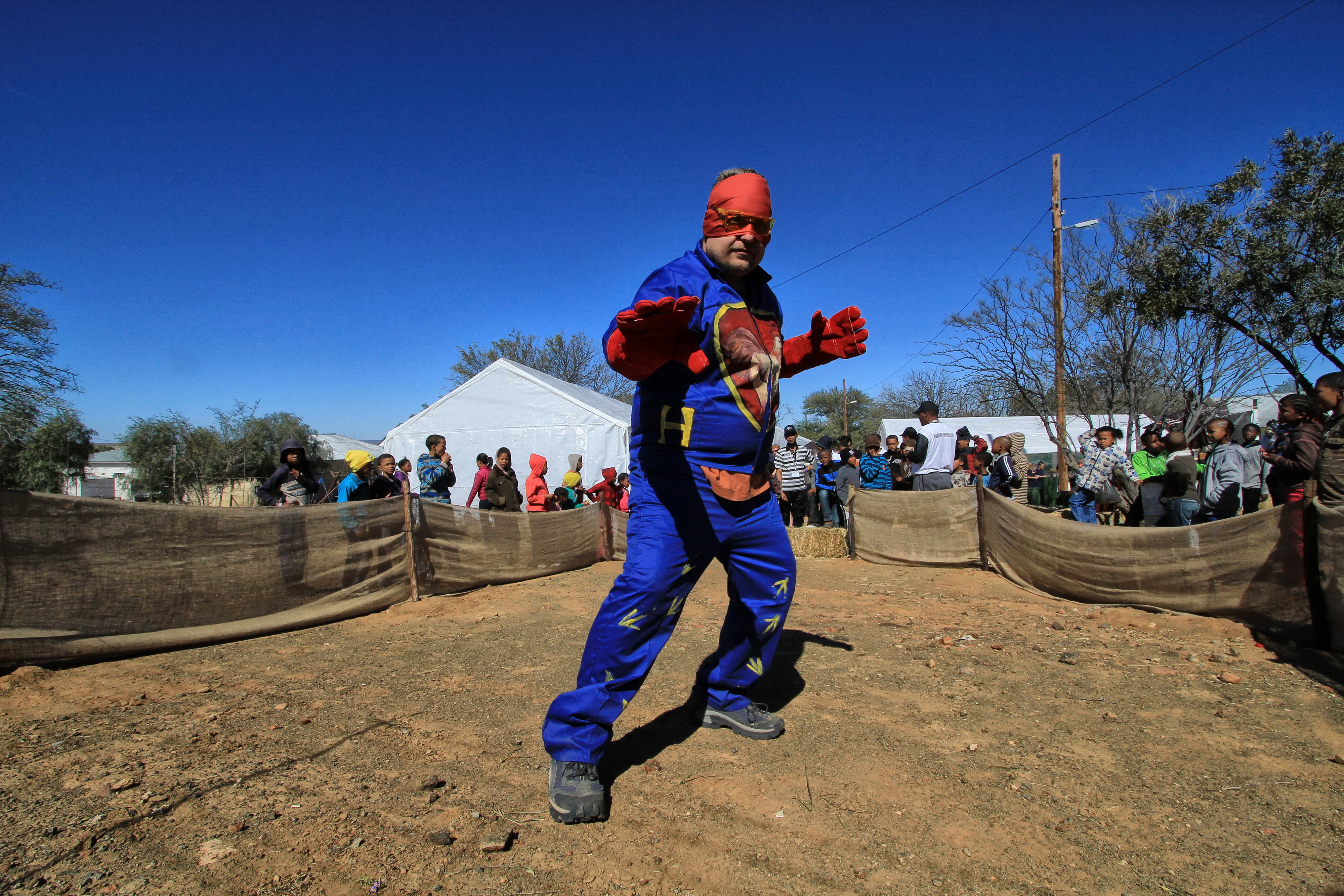
The Chicken Man once set up his stall at a Williston Winter Festival. Image: Chris Marais
A Chicken Man mask allows the wearer all manner of liberties. This jolly fellow thinks nothing of grabbing girls out of the crowd and performing a few dusty dance steps with them, doing celebrity selfies with others and sticking his tongue so far out it touches the tip of his chin. That’s some trick. Later on, we see him in his designated Hoenderman enclosure, being pelted with eggs at one rand a go, wincing in anticipation of pain when brawny young men take their turns at the shy.
“The big people throw hard,” he moans to us.
The Nama Riel
If you’ve never witnessed the Nama Riel in the flesh, tasted the dust of the Upper Karoo in your mouth or thrilled to the tune of Antie Katrina Die Honne Byt My, then make a new entry on your bucket list.
Who knows what the Nama Riel first looked like, back in the First People days before the trekboers and their colonial creditors pitched up here in the Northern Cape? Was it a San thing? Did it come from the KhoiKhoi?
What we do know is that it’s a working-class dance, performed like this for nearly a century in the tiny hamlets and on the isolated farmsteads of the Karoo. It tells lovers’ tales, it mimics everyday animals, it dramatises the hunt, it is danced in buckskins or boere outfits, and it moves to a magical rhythm.
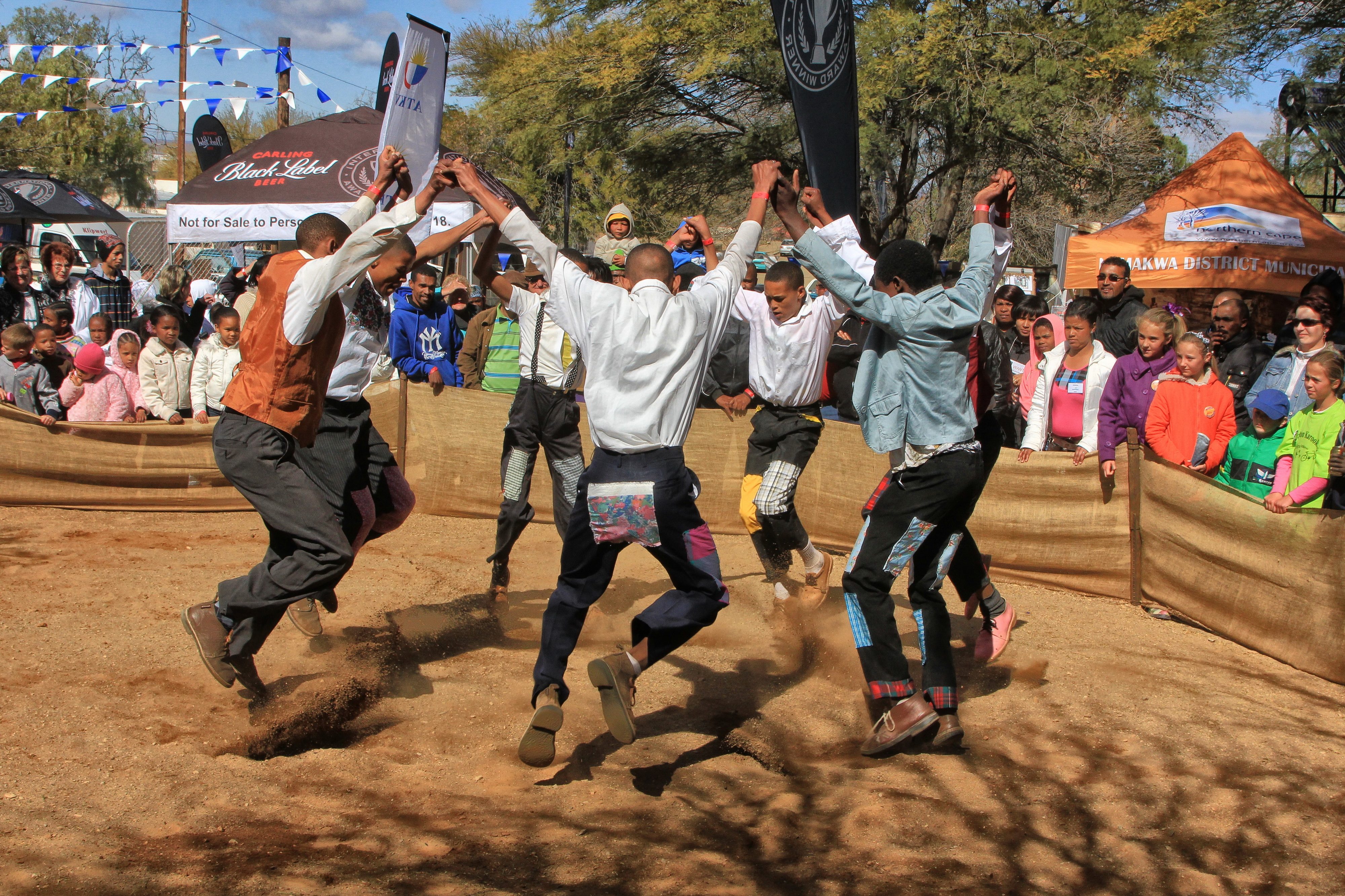
Young teenage suitors dance together before wooing their female counterparts. Image: Chris Marais
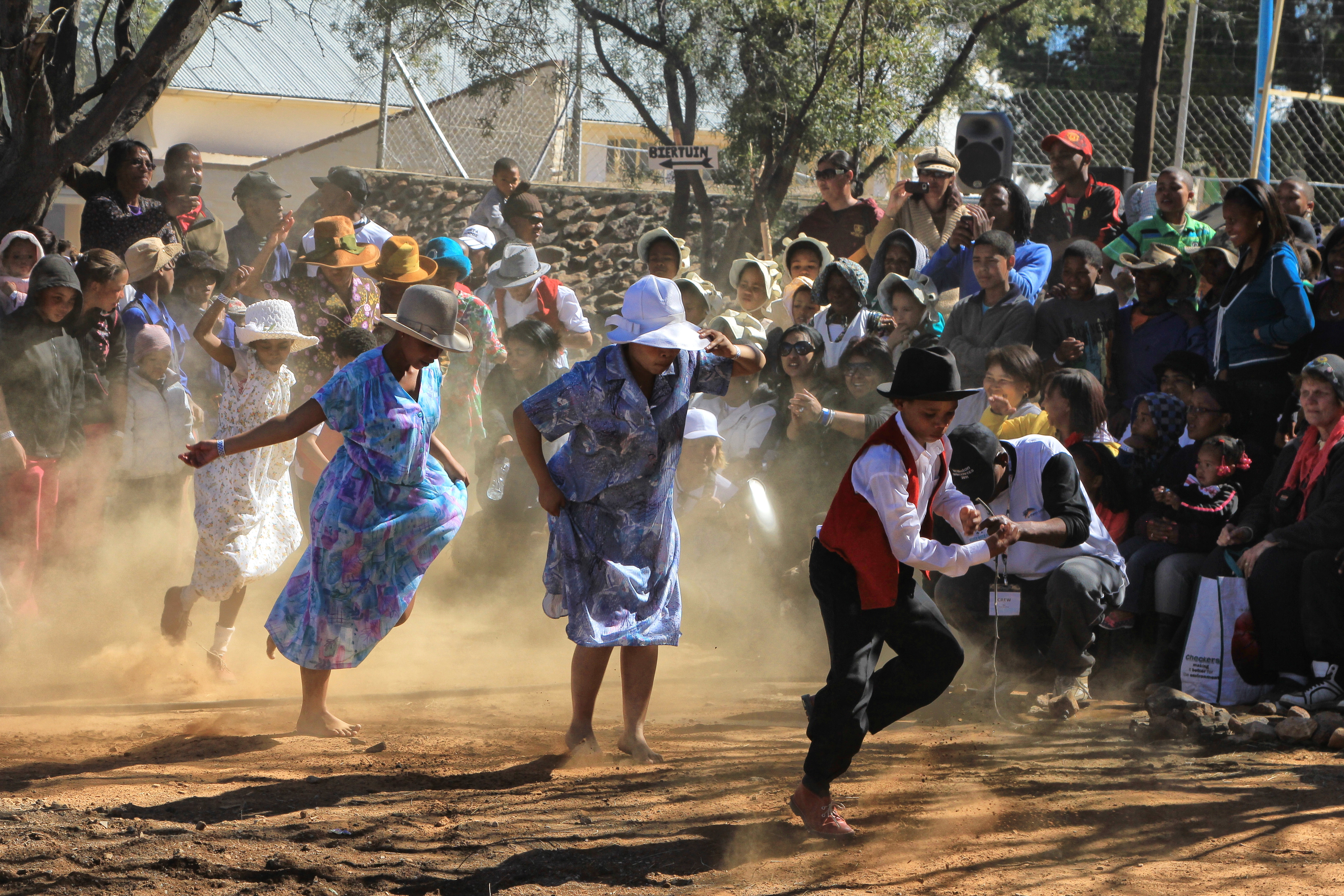
The dust rises in the arena, the crowd cheers and the dancers move with wild, timeless abandon. Image: Chris Marais
In the romantic version of the Rieldans, the hat is all-important. The boy lays it down in the dirt and, if the girl picks it up, he’s in favour. Great big ostrich feathers are an added attraction.
The Nama Riel is the true rock n roll of South Africa.
Willie Warmers
After the performances, we meander through the tiny retail nooks of the Williston Mall and learn all about “man mittens”.
In milder parts of the world, a willy warmer is a novelty item, one of those ironic presents men often find addressed to them under a Christmas tree. But willy warmers, AKA peter heaters or man mittens, serve a real purpose in cold countries like Croatia, where the shepherds up in the Mrkopali Mountains wear them to ward off frostbite.
In Norway, where they go by the names of vanakot or suspensorium, traditional willy warmers are made from squirrel fur (hairy side in for better insulation) and worn with leather pants when the chill sets in. Some Old School Norwegian islander girls still knit their beaus willy warmers as a sign of their affection. Woe betide the Viking who rejects such a gesture of love.
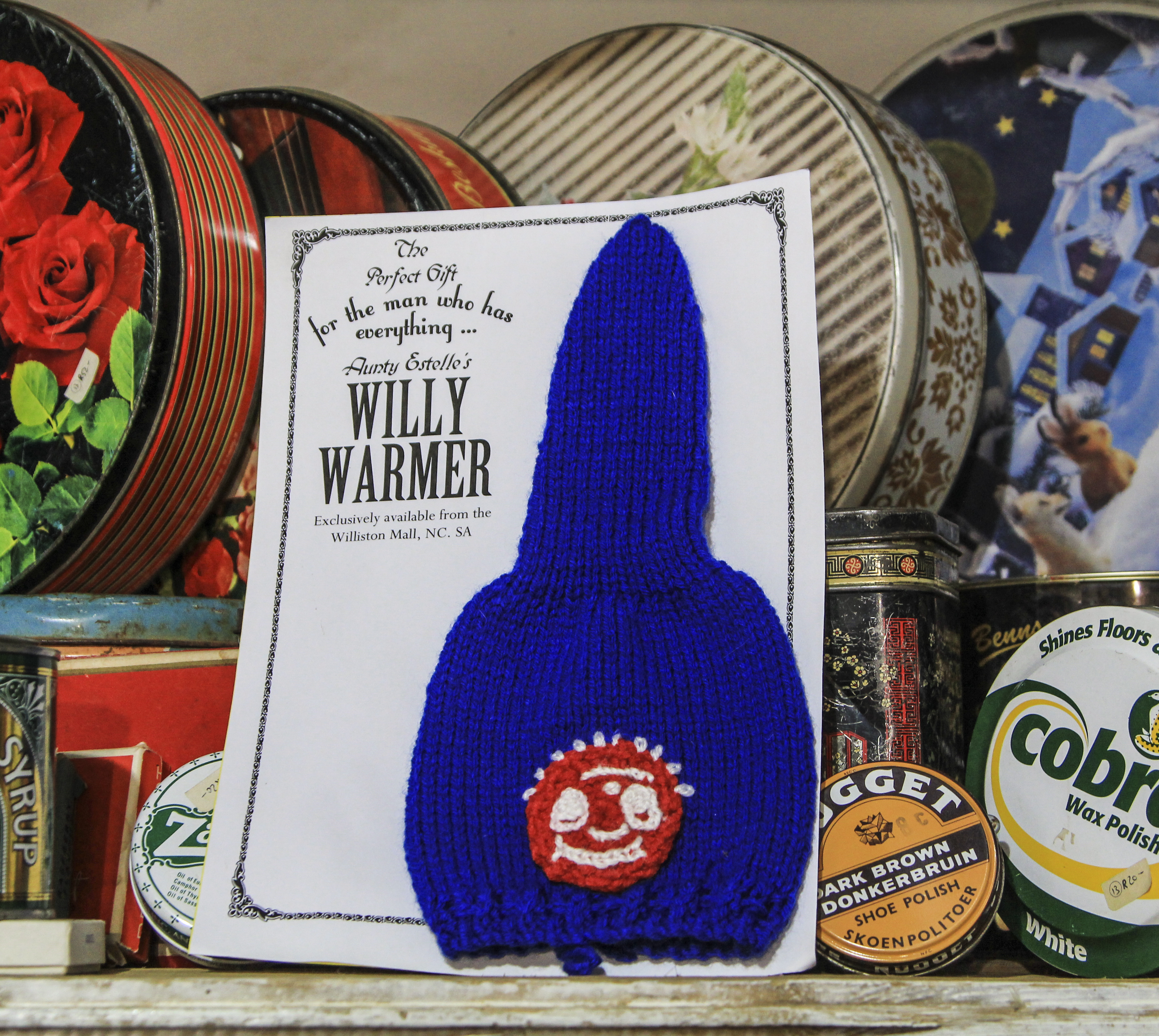
Willy Warmers, knitted by an anonymous local pensioner lady, are on sale at the Williston Mall shop. Image: Chris Marais
In the booties & beanies section of the shop in question, among the Zambuk, Cobra and Nugget tins, lurks a thoughtfully packaged willy warmer “for the man who has everything”.
Pieter Naude sources them from as far afield as Port Elizabeth and somewhere deep in the Tankwa Deserts.
“Then, of course, a lady who lives in the local retirement centre knits them for us as well.”
Who is this mitten-knittin’ mama? No one at the Williston Mall will say.
Frontier Cooking
Jules, in the meantime, has her nose deep in a Victorian-era bestseller called Kook en Koek Resepte (Recipes for Cooking and Baking), by Miss EJ Dykman of Paarl. Written in Dutch, the 14th edition alone carried a print order of 6,000 – huge by today’s local standards.
And why not? It tells the frontierswoman how to bake eggs, fry up beef steaks, prepare the perfect liver cake, make a candle, clean a piano, and, best of all, what to do when a snake bites you:
First, you drink as much brandy as it takes to make you sick. Then you catch a chicken, make a non-lethal cut to its neck and press it to the snakebite wound until the chicken dies. Then you catch another chicken and repeat the process. The book states that, generally speaking, eight to 10 chickens will do the trick.
With heads full of willy warmers and snake-and-chicken spells, we join Pieter Naude and friends in his pub, The Doppies Bar, which was once the hessian-covered milkshake oasis that drew us here in the first place.
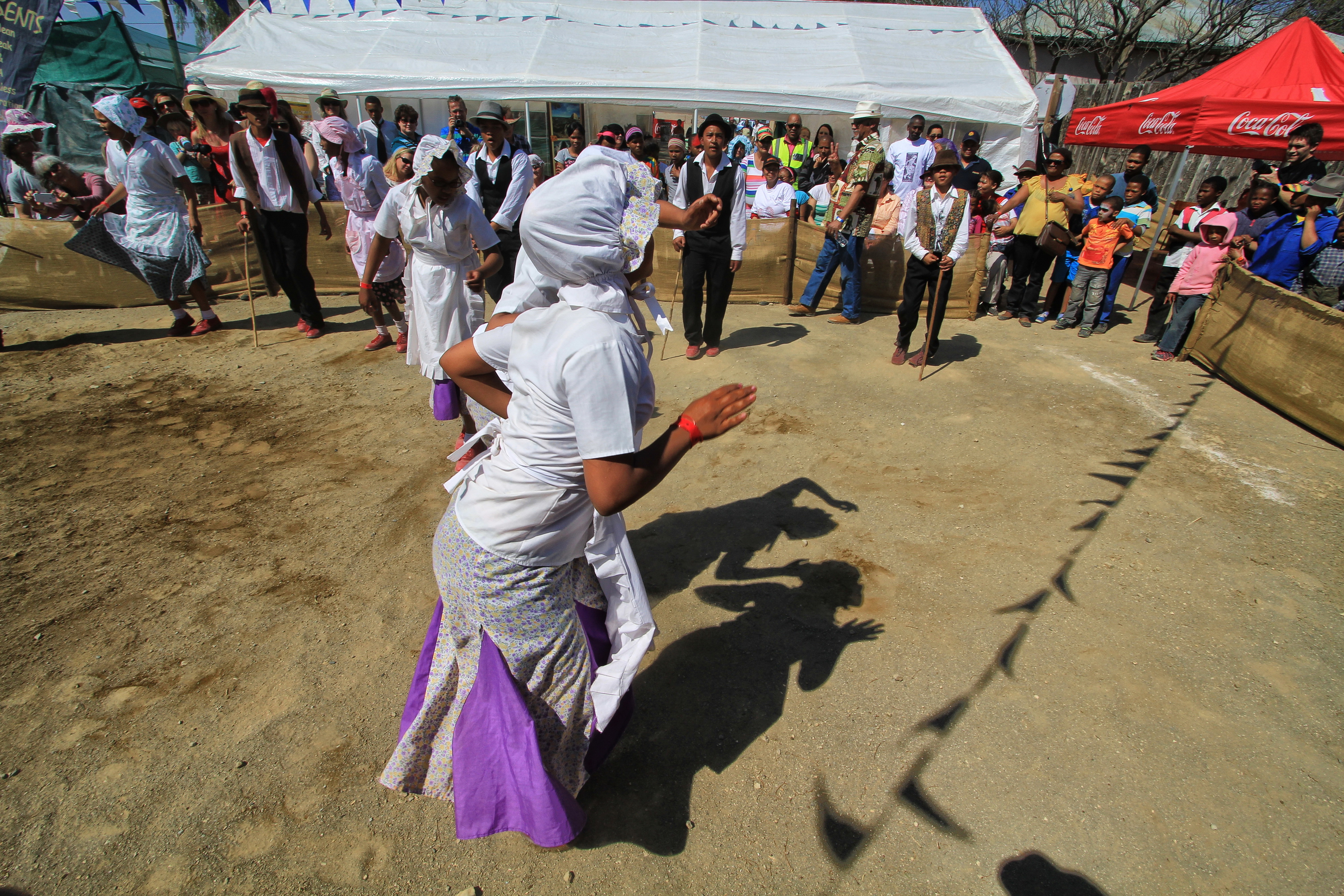
Shadow dancing – doing the Nama Riel at a Williston Winter Festival. Image: Chris Marais
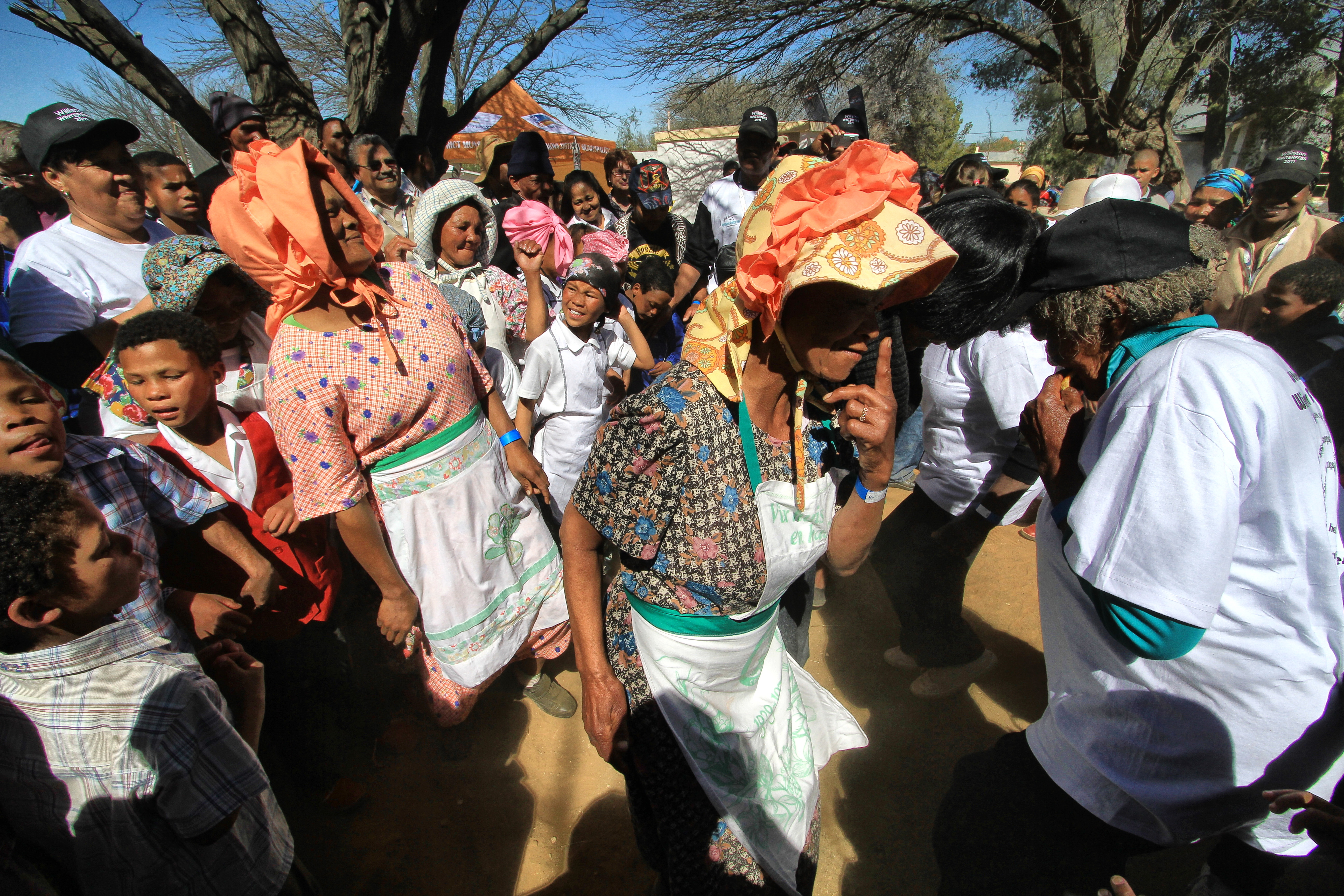
The old folks, with decades of muscle memory on their side, dance the Riel with great gusto. Image: Chris Marais
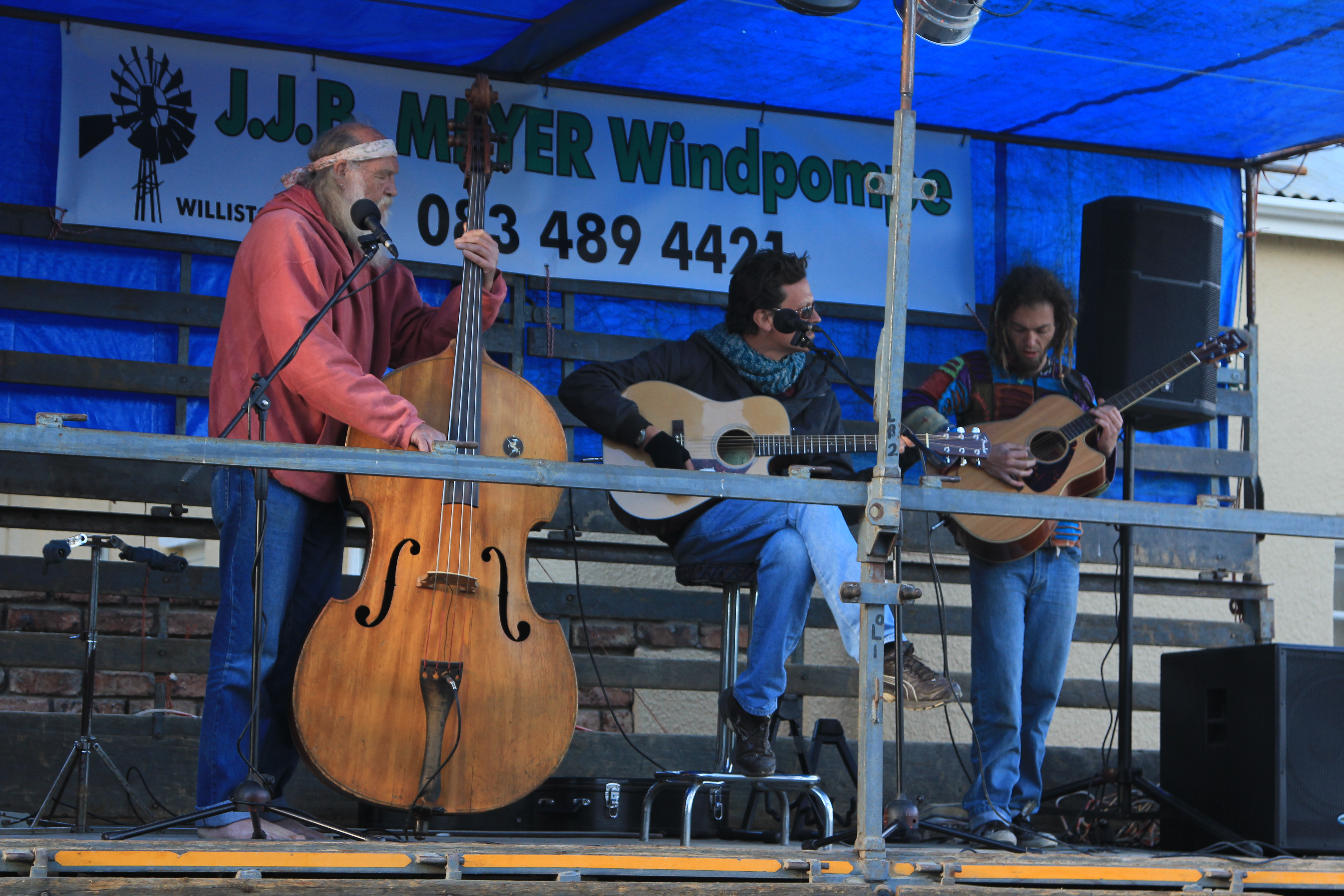
The Silver Creek Mountain Band at the 2012 festival, playing on the back of a sheep truck. Image: Chris Marais
The Inkommers
We discuss the subject of in-migration in South Africa: city folk moving to small towns for the quiet, the Wi-Fi, and the relative safety. But first, they have to negotiate the hurdle of being branded an inkommer (stranger) by the boorlinge (locals).
“The boorlinge have been here so long, streets are named after their families,” says Pieter. “Then you have inkommers, those like us who sell everything they have, move here and try to start a business. Then you get the kofferpakkers, the boorlinge who left, didn’t keep in touch, didn’t make it out there and came back. We inkommers tend to hang out with the kofferpakkers.”
We think about his words for a moment, and wonder: exactly what does it take to win total acceptance in a small Karoo town?
Just then, we hear the jingle-jangle of harnesses and the slow clop of hooves outside in the street, followed by soft words of endearment from a hard woman to her beloved donkeys, as they head home.
Some folks, it seems, simply march to their own drum. And that’s how you make it in the platteland. DM/ML
This is an extract from Karoo Roads II – More Tales from the Heartland, by Chris Marais and Julienne du Toit.
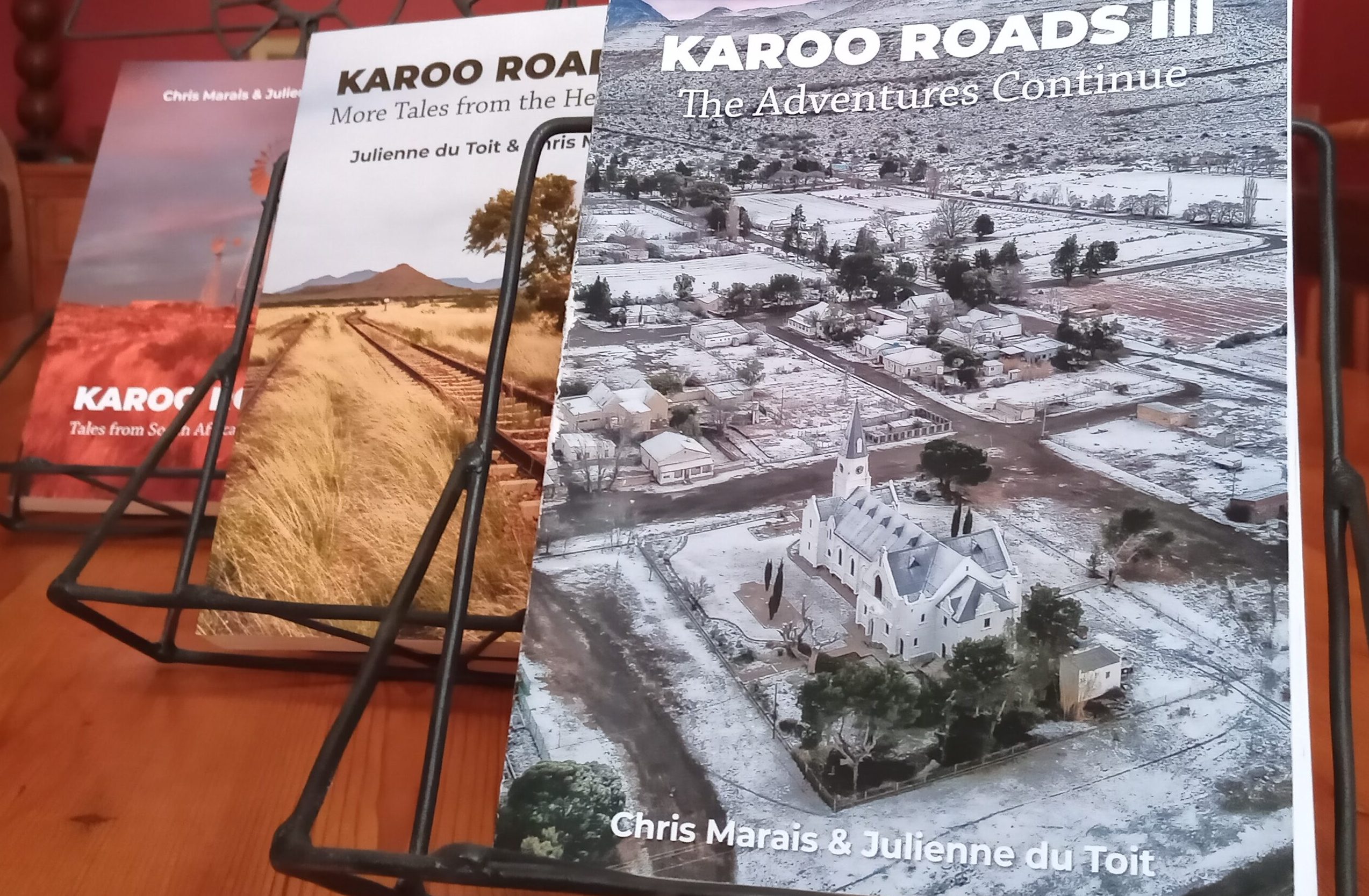
‘Karoo Roads’ Collection. Image: Chris Marais
For an insider’s view on life in the Dry Country, get the three-book special of Karoo Roads I, Karoo Roads II and Karoo Roads III (illustrated in black and white) for only R800, including courier costs in South Africa. For more details, contact Julie at [email protected]
Sadly, the Williston Winter Festival was suspended after the 2018 event. However, for more information (accommodation, cultural events, local activities) on the Williston Mall, see www.willistonmall.co.za




















Comments - Please login in order to comment.